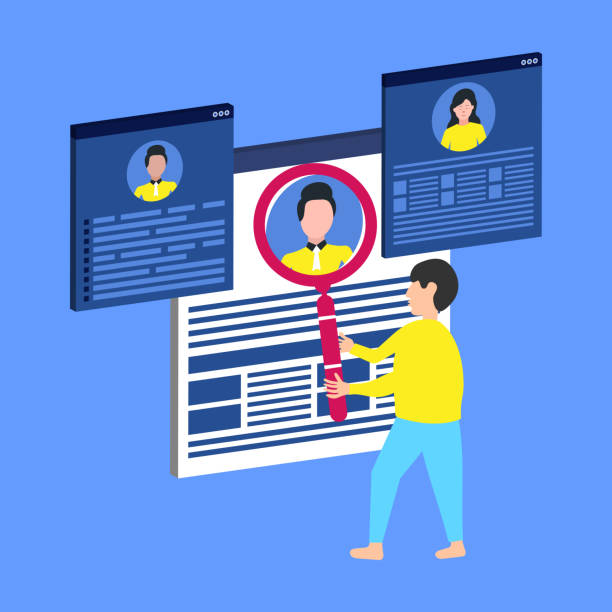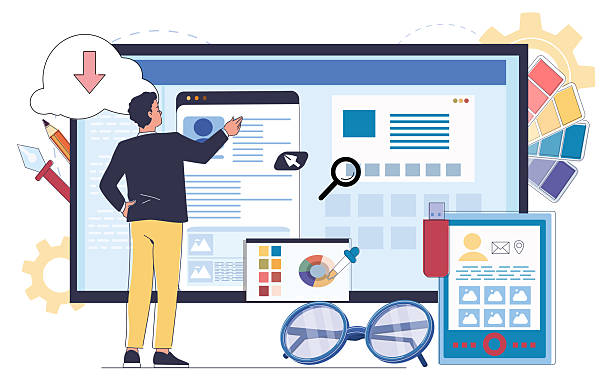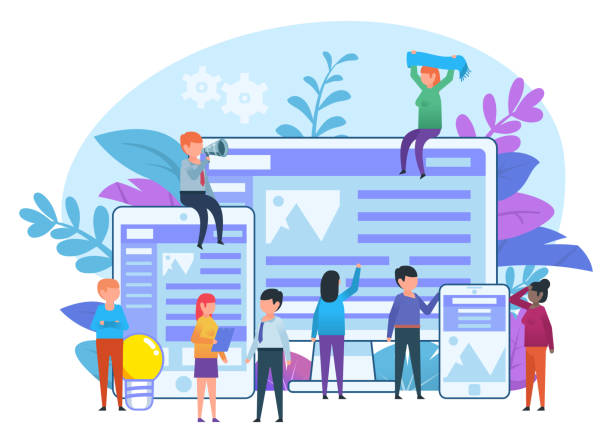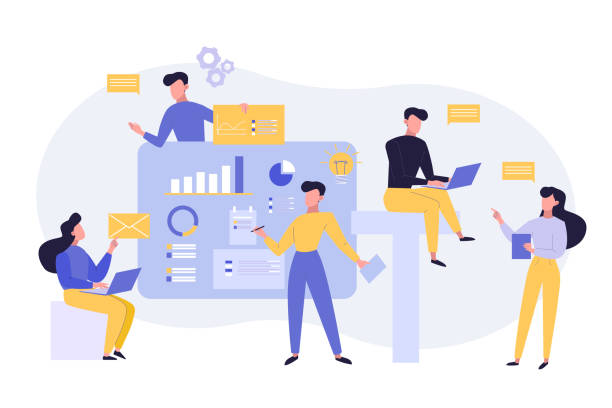Introducing the Importance of Fast Website Design in Today’s World

In the current digital age, #website_speed is no longer a competitive advantage, but an undeniable necessity.
Imagine visiting a website whose pages load slowly; what would your reaction be? Most likely, you would press the back button and move on to a competitor.
This unpleasant experience not only leads to losing users but also harms your brand’s credibility.
Therefore, fast website design is more vital than ever.
The goal of this article is to address various aspects of web speed and provide practical solutions for achieving it.
Website loading speed directly affects user experience (UX) and website ranking in search engines (SEO).
Studies have shown that even a one-second delay in page loading can lead to a significant decrease in conversions and page views.
For this reason, businesses and web developers must invest seriously in optimizing their site speed.
This investment will ultimately bring high returns in the form of increased user engagement, improved SEO, and consequently, increased sales.
User experience is a fundamental element of online success, and speed forms its backbone.
When a user encounters a slow website, they feel frustrated, and this negative feeling directly impacts their perception of your brand.
Conversely, a website that loads quickly conveys a sense of professionalism and respect for the user’s time.
This is especially important on mobile devices where internet speed can be variable.
Given the increasing use of mobile for internet access, ignoring mobile website speed means losing a large portion of potential audience.
Therefore, paying attention to fast website design is not just a preference but a strategic imperative for survival and growth in today’s competitive market.
In this journey, we will provide practical and specialized guidance for improving your website’s performance.
Does your company’s website create a professional and lasting first impression in the minds of potential customers? Rasaweb, with its professional corporate website design, not only represents your brand’s credibility but also paves the way for your business growth.
✅ Build a powerful and reliable brand image
✅ Attract target customers and increase sales
⚡ Get free consultation
Key Factors Affecting Website Speed

To achieve #fast_website_design, a precise understanding of the factors affecting website speed is essential.
These factors are technical in nature, and each can in turn affect your site’s overall performance.
One of the most important of these factors is #hosting_quality.
Poor and inadequate hosting, even with the best coding, can severely slow down your site.
Choosing a reputable hosting provider with powerful and optimized servers for your website is the first step towards increasing speed.
Next, we come to #image_size_and_optimization.
High-volume images without proper optimization can create a heavy load on the server and user bandwidth.
Compressing images without a noticeable loss in quality and using appropriate formats (like WebP) has a significant impact on reducing loading time.
Next, #optimized_coding and #code_size become important.
Bulky CSS and JavaScript codes, uncompressed and without proper order, can slow down browser processing.
Minification and concatenation of CSS and JavaScript files, along with asynchronous loading, are key techniques in this area.
Excessive use of plugins in content management systems like WordPress can also severely reduce site speed.
Each plugin loads additional code, which ultimately leads to slowness.
Therefore, careful selection of plugins and removal of unnecessary ones are of high importance.
#Using_a_CDN (Content Delivery Network) is another effective solution.
A CDN stores your website’s static content (such as images, CSS, and JS) on various geographical servers.
When a user accesses your site, content is delivered from the server closest to them, which significantly reduces loading time.
#Caching also plays a vital role.
By caching content, the user’s browser does not have to request all information from the server every time, but instead uses the version stored in its local memory.
These factors together demonstrate the complexities of fast website design and require a comprehensive and technical approach.
Advanced Tools and Techniques for Increasing Site Speed

To achieve #optimal_performance and #fast_website_design, familiarity with and application of specialized tools and advanced techniques are essential.
This section introduces some of the most important tools and technical approaches that can significantly increase your website’s loading speed.
The first step is to use #website_speed_analysis tools like Google PageSpeed Insights, GTmetrix, and Pingdom Tools.
These tools identify your site’s weaknesses and offer suggestions for improvement, which include image compression, code optimization, and the use of caching.
One of the widely used techniques is advanced image optimization.
In addition to standard compression, using “Lazy Loading” (lazy loading) for images is very effective; this means images are only loaded when the user scrolls to the relevant section.
Also, the use of next-generation formats like WebP, which have smaller file sizes, is recommended.
Lazy Loading can significantly improve user experience.
Another technique is code minification and compression (Minification and Gzip Compression).
These processes involve removing unnecessary characters (like comments and whitespace) from HTML, CSS, and JavaScript codes, and then compressing the files to reduce their size before sending them to the user’s browser.
This makes a significant difference, especially in large websites with extensive code.
Using a CDN (Content Delivery Network), as mentioned earlier, helps distribute your static content to servers closer to users and reduces response time.
Correct server and browser caching configuration is also crucial.
This ensures that for subsequent visits, the browser uses cached versions of files, eliminating the need for re-downloading.
Finally, upgrading to new PHP versions (such as PHP 8.x) and using high-performance web servers like Nginx or Apache with optimized configurations can significantly increase the speed of request processing.
For databases, optimizing queries and using indexes for faster access to information are essential.
Additionally, using advanced database caching systems like Redis or Memcached can optimize performance on high-traffic sites.
This set of specialized actions maximizes your website’s potential to become a truly fast website and is highly effective in achieving fast website design.
| Technique | Description | Related Tools | Impact on Speed |
|---|---|---|---|
| Image Optimization | Compression, resizing, using next-gen formats (WebP), Lazy Loading | TinyPNG, ImageOptim, Imagify | Very high (reduces main page size) |
| Code Minification and Compression | Removing extra characters from HTML/CSS/JS, Gzip compression | WP Rocket, Autoptimize, Online Minifiers | High (reduces size of transmitted files) |
| Caching | Temporary storage of content on the server or user’s browser | W3 Total Cache, LiteSpeed Cache, Cloudflare | Very high (reduces server requests) |
| Using CDN | Distributing content across different geographical servers | Cloudflare, KeyCDN, Akamai | High (reduces latency) |
| Server and Database Optimization | PHP upgrade, using high-speed servers, query optimization | MySQL Workbench, PHP-FPM, Redis | Medium to high (reduces processing time) |
The Impact of Fast Website Design on SEO and Google Ranking

In today’s competitive world, #SEO (Search Engine Optimization) is one of the main pillars of online success for any business.
Among the critical factors that Google and other search engines prioritize is #website_loading_speed.
This close connection means that fast website design directly impacts your site’s ranking and visibility in search results.
Google has officially announced that page speed is a ranking factor, especially for mobile searches, where its importance has doubled with the introduction of Core Web Vitals.
Core Web Vitals include three main metrics: LCP (Largest Contentful Paint), which measures the loading time of the largest visual content on the page; FID (First Input Delay), which indicates the site’s responsiveness to the user’s first interaction; and CLS (Cumulative Layout Shift), which assesses the visual stability of the page.
Improving each of these metrics requires efforts towards website speed optimization.
When your website loads faster, the bounce rate decreases.
Users are less likely to leave the page and are more inclined to browse other pages on the site.
This user behavior sends a positive signal to search engines that your site offers valuable content and a good user experience.
As a result, Google’s algorithms consider your site for higher rankings.
Furthermore, high speed helps search engine crawlers index more pages in a shorter time.
This means your new content is discovered more quickly by Google and displayed in search results, which is crucial for sites that regularly update content (such as news sites or blogs).
Adhering to SEO principles and speed is a winning combination for increasing organic traffic.
Investing in fast website design means investing in the future of your online business.
Ignoring speed can not only harm your SEO ranking but also lead to losing the potential to acquire new customers.
Ultimately, fast websites attract more traffic, have higher conversion rates, and are generally more successful.
It is an undeniable truth in today’s digital marketing that website speed is a decisive factor in success and should be given special attention from the very beginning of the design and development process.
This will directly impact your online credibility and business revenue.
Are you worried about losing customers because you don’t have a professional e-commerce website?
With e-commerce website design by Rasaweb, forget those worries!
✅ Significant increase in sales and visitor-to-customer conversion rate
✅ Professional and user-friendly design that builds customer trust
⚡ Get free consultation from Rasaweb
User Experience and the Role of Speed in Visitor Satisfaction

#User_Experience (User Experience or UX) and #User_Satisfaction are two inseparable concepts in the success of any website.
At the heart of these two concepts lies #website_speed.
Nothing can degrade the user experience and quickly lead to visitor dissatisfaction as much as a slow website.
Today, users expect websites to load instantly, and if this expectation is not met, they quickly leave the site and turn to your competitors.
This behavior is known as “Pogo-sticking” and severely damages your site’s SEO and credibility.
Therefore, fast website design is an essential step towards providing a flawless user experience.
When a website is fast, users can navigate between pages seamlessly, quickly view content, and easily perform their interactions.
This not only increases their satisfaction but also leads to an increase in Dwell Time on the site and a reduction in Bounce Rate.
A website that loads quickly conveys a sense of professionalism and credibility to the user, and this trust can turn into customer loyalty.
Research shows that most users wait a maximum of 3 seconds for a page to load, and if it doesn’t, they leave it.
In the world of e-commerce, speed plays an even more critical role; every second of loading delay can mean losing thousands of dollars in sales.
Speed optimization for online stores is essential.
Additionally, website speed directly impacts Accessibility.
Users with slower internet or older devices are more affected by low speeds.
A fast website is accessible to a wider range of users, contributing to your brand’s inclusiveness and reach.
Responsive Design, coupled with speed optimization, ensures that your website provides a positive user experience on any device and at any speed.
Ultimately, the goal of any website is to attract and retain users.
Fast website design not only aids your SEO and technical goals but also acts as a decisive factor in building a positive and lasting relationship with your audience.
This is the foundation of any successful digital marketing strategy that prioritizes user satisfaction.
Challenges and Obstacles in Fast Website Design

Despite all the advantages of #fast_website_design, achieving it is not without challenges.
The path to speed optimization can be complex and full of technical and operational obstacles, requiring specialized knowledge and continuous effort.
One of the biggest challenges is the #volume_and_complexity_of_modern_websites.
Today, websites are full of high-quality images, interactive videos, JavaScript scripts for advanced functionalities, and custom fonts.
Each of these elements adds to the overall page size and increases loading time.
Proper management of these assets, without sacrificing the beauty and functionality of the website, is both an art and a science.
#Inadequate_or_insufficient_hosting is also a major obstacle.
Many websites use shared hosting with limited resources that cannot handle high traffic or complex requests.
Even with excellent client-side optimizations, a slow server can nullify all efforts.
Choosing a suitable and quality hosting is an essential investment.
Another challenge is the #improper_use_of_plugins_and_frameworks.
In content management systems like WordPress, using too many plugins or low-quality plugins can create additional code, more HTTP requests, and compatibility issues, all of which lead to site slowdown.
#Dependency_on_external_resources can also reduce speed.
Using Google Fonts, analytical scripts, YouTube videos, and social media tools that are loaded from other servers can affect your site’s speed due to delays in third-party server responses.
Developers must carefully manage these dependencies.
Finally, the #need_for_continuous_maintenance_and_updates is also a challenge.
Speed optimization is not a one-time process; with new content additions, design changes, and technology updates, re-evaluation and re-optimization may be necessary.
These complexities indicate that fast website design is not just a technical process but a long-term strategy that requires continuous commitment and expertise to meet the growing expectations of users and search engines.
Case Study of Businesses’ Successes with Fast Websites

To gain a deeper understanding of the impact of #fast_website_design, looking at case studies and the successes of businesses that have optimized their website speed can be very insightful.
These examples demonstrate how investing in increasing site speed can directly lead to revenue growth, improved customer experience, and strengthened brand positioning.
One of the most well-known examples is Amazon.
Years ago, Amazon announced that every 100-millisecond delay in page load could lead to a 1% decrease in their sales.
These figures highlight the critical importance of speed in e-commerce environments.
Amazon continuously invests in optimizing its infrastructure to ensure the fastest possible loading times.
Another example is Walmart.
After improving their site speed by one second, Walmart saw a 2% increase in conversion rate and a 97% increase in mobile conversion rate.
These numbers clearly show that even small improvements in loading speed can have significant financial impacts.
These improvements are not just due to technical factors but because users feel more comfortable in a fast environment and gain more confidence to complete their purchases.
Facebook is another company that has understood the importance of speed.
They realized that even a few milliseconds’ reduction in news feed loading speed could lead to decreased user engagement.
For this reason, they continuously work on optimizing their content loading and caching algorithms to provide the best possible user experience.
These examples show that fast website design is crucial not only for large businesses but for any website seeking success and sustainable growth in the online space.
It is not just a technical factor, but a strategic factor for competitiveness in the digital market.
These examples should serve as motivation for every business to seriously prioritize their website speed.
| Company | Change in Speed | Observed Impact | Lesson Learned |
|---|---|---|---|
| Amazon | Every 100ms delay | 1% decrease in sales | Even minor delays have a direct financial impact. |
| Walmart | 1-second improvement | 2% increase in conversion rate, 97% increase in mobile conversion rate | Small improvements in speed yield high returns. |
| Several milliseconds reduction | Decrease in user engagement | Speed is vital for user experience and engagement. | |
| 0.5-second display speed reduction | 20% decrease in searches | Users are accustomed to speed, even in search engines. |
The Future of Web Design and the Necessity of Speed in It

With the ever-advancing technology and increasing user expectations, the #future_of_web_design is increasingly centered around #speed_and_efficiency.
This is not just a temporary trend, but a fundamental paradigm shift in which fast website design will become an absolute necessity.
The emergence of new technologies like 5G, Web3, and the Metaverse further highlights the need for incredibly fast and responsive websites.
In these novel ecosystems, every millisecond matters, as user experience is no longer limited to browsing a page but includes complex interactions, virtual reality, and augmented reality.
Concepts such as PWA (Progressive Web Apps) also play a significant role in the future.
PWAs are websites that bring native mobile app capabilities to browsers, including offline functionality and incredibly fast loading.
This technology shows that the line between web and native applications is blurring, and users expect websites to perform with the same speed and fluidity as mobile applications.
Optimizing for Core Web Vitals will become even more critical in the future.
Google continuously emphasizes the importance of these metrics, and developers must actively focus on improving LCP, FID, and CLS to not only succeed in SEO but also provide an outstanding user experience.
Server-side technologies like HTTP/3 and Brotli Compression will also be more widely adopted to ensure that data is transmitted at the maximum possible speed.
Furthermore, with the increasing complexity of web designs and the need for richer interactions, the use of lightweight and efficient frameworks, as well as new architectures like JAMstack (JavaScript, APIs, Markup) that inherently focus on speed and security, will become more prevalent.
These approaches, by pre-loading content and reducing dependency on dynamic servers, help achieve fast websites.
In summary, the future of web design is one where speed is not just a desirable feature but an absolute prerequisite for any successful online presence.
Businesses and developers who understand this shift in time and invest in fast website design will remain at the forefront of innovation and competitiveness.
Tired of missing out on business opportunities due to not having a professional corporate website? Worry no more! With Rasaweb’s corporate website design services:
✅ Your brand’s credibility and professionalism will increase.
✅ You will attract more customers and sales leads.
⚡ Get a free consultation now to get started!
Critical Tips for Choosing a Fast Website Design Company

Choosing the right #website_design_company that focuses on #speed_and_optimization can make a significant difference in the online success of your business.
This choice should be made with care and diligence, as fast website design does not only mean visual aesthetics but also performance, SEO, and user experience.
In this section, we will discuss critical tips for choosing such a company.
The first tip is to review their portfolio and case studies.
A reputable company in the field of fast website design should have a portfolio of projects that are not only visually appealing but also score highly on speed testing tools like Google PageSpeed Insights and GTmetrix.
Requesting performance reports of the sites they have designed can indicate their commitment to speed.
Additionally, studying case studies of previous projects where speed optimization was addressed can be very helpful.
Second, evaluate the technical knowledge and expertise of the team.
Are they familiar with concepts such as CDN, server-side and client-side caching, Minification, Lazy Loading, and database optimization, and do they have practical experience in implementing them? Asking specific technical questions and observing their responses can indicate their level of expertise.
A company that only focuses on aesthetics and neglects the technical aspects of speed is not the right choice for your fast website design.
Third, consider post-design services and support.
Speed optimization is an ongoing process.
Does your chosen company offer maintenance and update services to maintain site speed? Do they have monitoring tools to track site performance after launch? These issues are as important as the initial design.
Continuous support is vital for maintaining speed.
Fourth, transparency in costs and processes.
A professional company should clearly explain what services they offer for speed optimization and how the related costs are calculated.
Avoid ambiguities in the work process and costs.
Finally, check feedback from previous clients.
Testimonials from former clients can provide valuable insights into the company’s reliability, professionalism, and commitment to results.
By considering these tips, you can choose a company that delivers a website that is not only beautiful but also incredibly fast and optimized for you.
Conclusion and Why Fast Website Design is a Smart Investment

At the end of this article, we can clearly state that #fast_website_design is no longer a luxury choice but a #smart_and_essential_investment for any business and individual seeking success in the online space.
Throughout these discussions, we have thoroughly examined how website speed directly impacts not only user experience but also SEO, conversion rates, and ultimately, your brand’s revenue and credibility.
There are several reasons to prove this claim: Firstly, user satisfaction.
Today’s users are impatient and expect content to be immediately available.
Slow websites lead to frustration and site abandonment, while fast websites help retain customer loyalty.
Secondly, SEO improvement.
Search engines like Google consider page speed as an important ranking factor.
Faster websites achieve better rankings in search results and attract more organic traffic.
Thirdly, increased conversion rates.
Case studies have shown that even a slight reduction in loading time can lead to a significant increase in sales and conversions, as users more easily complete purchase and registration processes.
Fourthly, competitive advantage.
In digital marketing, where competition is fierce, having a fast website can distinguish you from competitors.
This is a key factor for attracting and retaining customers in the long term.
Your digital marketing strategy must have speed at its core.
Fifthly, future readiness.
With technological advancements and the emergence of new platforms (such as Web3 and the Metaverse), the need for high speed and performance will only increase.
Investing in fast website design today means being prepared for tomorrow’s challenges.
Considering all these factors, it is clear that the cost spent on fast website design is not an expense, but an investment whose returns will come back to you in various forms (from increased traffic and sales to improved brand credibility).
This approach helps you not only survive but also thrive in today’s fast-paced digital world and achieve your business goals.
Any forward-thinking business should prioritize website speed.
Frequently Asked Questions
| Question | Answer |
|---|---|
| What is the concept of fast website design? | It refers to the process of building a website whose pages load at high speed and in minimal time for users. |
| Why is website speed important? | Website speed is crucial for a better user experience, reducing visitor bounce rates, increasing page views, and improving search engine rankings (SEO). |
| What factors affect website loading speed? | Image and file size, inefficient coding, server speed and location, lack of caching and CDN usage, and a large number of HTTP requests. |
| What is the role of images in website speed? | High-volume images can severely reduce site speed. They should be compressed, optimized, and used in appropriate formats. |
| Is hosting server speed important? | Yes, server response speed has a direct impact on the initial loading time of the site. Choosing suitable hosting is very important. |
| How does website coding affect speed? | Clean, optimized, minified, and error-free coding reduces file sizes and increases processing speed. |
| How does using Caching help? | Caching allows the user’s browser to store some site information, so in subsequent visits, there is no need to reload everything, and the site appears faster. |
| Do extra plugins and scripts slow down the website? | Yes, excessive or improper use of plugins, widgets, and extra scripts can cause the site to slow down. |
| How can website speed be tested? | By using reputable online tools such as Google PageSpeed Insights, GTmetrix, or Pingdom Tools. |
| What are the key tips for fast website design? | Image optimization, using a CDN, enabling caching, reducing HTTP requests, optimizing CSS and JavaScript, and choosing quality hosting. |
And other services of Rasa Web Advertising Agency in the field of advertising
Smart Link Building: An innovative service to increase user engagement through intelligent data analysis.
Smart Website Development: An effective tool for analyzing customer behavior using intelligent data analysis.
Smart Content Strategy: Professional optimization to increase sales using intelligent data analysis.
Smart UI/UX: A fast and efficient solution for digital branding with a focus on customizing user experience.
Smart Sales Automation: An effective tool for campaign management by optimizing key pages.
And over a hundred other services in the field of internet advertising, advertising consultation, and organizational solutions
Internet Advertising | Advertising Strategy | Advertorial
Resources
Website Speed Optimization
Fast Website Design Tips
Website Performance Improvement Guide
Comprehensive Website Design Guide
? Rasaweb Afarin Digital Marketing Agency, your partner in the fast-paced journey of your business growth with professional services such as corporate website design and SEO optimization.
📍 Tehran, Mirdamad Street, next to Bank Markazi, Kazeroun Jonoubi Alley, Ramin Alley, No. 6



